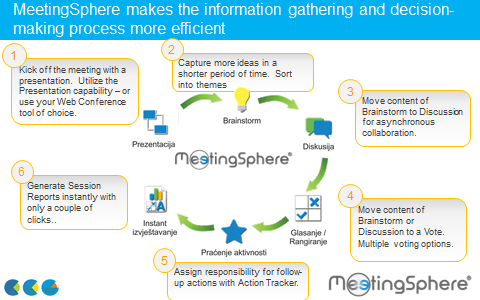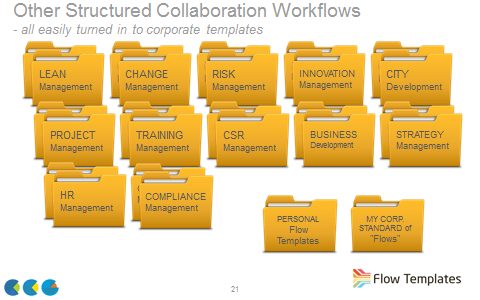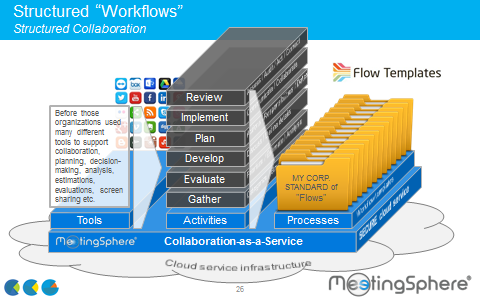I’ve been asked to share some information on MeetingSphere - Group Decision Support System …
Efficiency
With MeetingSphere meetings deliver expected results 6-8 times faster than compared to meetings without. A Danish client that also is a blogger wrote that “What CCG did in 45 minutes had taken the organization 4-5 days to do otherwise”. Read her blog (Danish): “Virksomheder møder sig fattige”.
We have also data from an English governmental agency that shows a ratio 1:6 between with or without MeetingSphere. Also the paper Group Decision Support System, a case study I wrote to the GMSS indicates the same ratios both for time and cost savings.
3 reasons for MeetingSphere
- Significantly shorter, structured meetings with results
- Automatic, transparent and compliant documentation
- Interactive, barrier-free (asynchronous) communication over the internet
Anyone – Anytime – Anywhere participation!
Features
MeetingSphere is a unique online meeting tool known as an Electronic Meeting System (EMS) or Group Decision Support System (GDSS) which is designed to:
- Actively engage participants in face-to-face, online or hybrid meetings
- Generate a higher volume of inputs
- Allow people to say what is really on their minds (ANONYMOUSLY)
- Support online team collaboration (synchronous and asynchronous)
- Save time and eliminate unnecessary work, administration, and travels
- Bring accountability and transparency to the decision-making process
“Real work in real time”
The best of all is the “Instant Reporting” feature - with a click of a button …
“Thank you for a great meeting - the report is in your mail!”
MeetingSphere is user-controlled, i.e. it’s you as end-user that build and run structured dialogs. They can e.g. look like this pictures shows …

MeetingSphere supports any kind of structured process and templates are easily developed and shared among meeting facilitators …

“Appification” with hundreds of different logins are becoming a big problems for organsations. Staff introduces new “cool” app’s in an increasing speed. MeetingSphere is a complete “toolbox” that help organisations to avoid this stress. The picture shows the activities that MeetingSphere has different tools for. With MeetingSphere most app’s are not required anymore…

In case you are interested to test MeetingSphere - send us a message and we will help you to get started.
CustomerCare@CCGEurope.com
More information on MeetingSphere can be found at the vendor web
www.MeetingSphere.com
Offer to friends of CCG
Before writing this topic I talked with MeetingSphere and they will give a special deal to people at this community. You only have to refer to “Friend of CCG” when signing up for a subscription to get a 10% discount. But before doing this you should sign up for a free trial.
The history of Group Decision Support Systems
Definition of GDSS
Designed with the goal of supporting groups of decision-makers in their work. Easy to learn and use. The GDSS can be designed for any type of problem or supporting group-level organizational decisions. It encourages generation of ideas, resolution of conflicts, and freedom of expression. It has built-in mechanisms that discourage development of negative group behaviours, such as destructive conflict, miscommunication and “groupthink”.
GDSSs improves the productivity of decision-making meetings, either by speeding up the decision-making process or by improving the quality of the resulting decisions, or both. This is accomplished by providing support for the exchange of ideas, opinions, and preferences within the group.
• Supporting parallel processing of information and idea generation by participants.
• Enabling larger groups to participate in the same meeting, establishing common ground.
• Permitting the group to use structured or unstructured techniques and methods of arriving at decisions.
• Offering rapid and easy access to external information.
• Allowing non-sequential (asynchronous) computer discussion. (Unlike oral discussions, computer discussions do not have to be serial or sequential.)
• Producing instant, anonymous voting results.
• Providing structure to the planning process, which keeps the group on track.
• Enabling several users to interact simultaneously.
• Automatically recording of all information that passes through the system for future analysis (it develops organization memory).
• Automatic report generator, so when the work is over the report is also finished and can be momentarily distributed to participants.
Development started in the 1980s
Electronic GDSS has developed significantly since the 1980s, helping organizations like NASA, Intel, IBM and P&G to build better company communication networks and make decisions that enhance company services and growth. Advances in electronic infrastructure, processing, meeting space, and communication are just a few examples of how GDSS can improve organizational decision-making processes.
High-level managers can spend 80% of their time making decisions in groups. Applied correctly, GDSS can reduce this time, arriving at better decisions faster. Since 1980s GDSS providers have developed the platform and today GDSS is used in endless different kinds of applications, such as citizen engagement processes, city development processes, disaster risk analysis, strategy development, Triple and Quad Helix process management, Open Innovation management, and many more areas.
GDSS today
Since today’s GDSS is based on behavioural science, i.e. it totally stops all negative powers that influence and have negative impact on people, it assures that people can speak out, tell the truth, dare to say what’s on their mind, and as result corruption can be solved, nepotism among the political elite is stopped, and total democracy is guaranteed. GDSS of today is an engine for fast democratic workflows. GDSS of today comes as Software-as-a-Service and is easily designed for any kind of group-decision process, e.g. polls, voting’s, co-creation activities such as Triple or Quad Helix processes, project management of complex projects, handle culture differences on groups, and many more areas.
At the pen …
Pierre Wettergren, CEO Clever Collaboration Group
